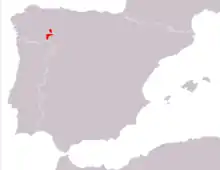| Leonese rock lizard | |
|---|---|
 | |
| Scientific classification | |
| Domain: | Eukaryota |
| Kingdom: | Animalia |
| Phylum: | Chordata |
| Class: | Reptilia |
| Order: | Squamata |
| Family: | Lacertidae |
| Genus: | Iberolacerta |
| Species: | I. galani |
| Binomial name | |
| Iberolacerta galani | |
 | |
| Distribution of the Leonese rock lizard. | |
The Leonese rock lizard (Iberolacerta galani), also known as Galan's rock lizard, is a species of lizard in the family Lacertidae. The species is indigenous to Spain.
Geographic range
The species I. galani is endemic to the Montes de León in northwestern Spain.[1]
Etymology
Its specific name, galani, honors the Corunnan herpetologist Dr. Pedro Galán Regalado[2] for his lifelong dedication to the study of the Iberian herpetofauna and natural history in general.[3]
Description
This species, I. galani, is characterized by its relatively large size. It is the biggest species of Iberolacerta with females reaching 84 mm (3.3 in) snout-to-vent length (SVL). It is also characterized by a high number of blue ocelli on the shoulders, and the relatively frequent contact or near-contact between the supranasal and the first loreal scale.[3]
Habitat
The Leonese rock lizard inhabits rocky supraforestal (above the tree line) habitats, at 1,000–2,000 m (3,300–6,600 ft),[1] with a high-mountain climate.[3]
Reproduction
References
- 1 2 3 4 Arribas, Oscar (2009). "Iberolacerta galani ". IUCN Red List of Threatened Species. 2009: e.T157271A5066930. doi:10.2305/IUCN.UK.2009.RLTS.T157271A5066930.en. Retrieved 11 November 2021.
- ↑ Beolens, Bo; Watkins, Michael; Grayson, Michael (2011). The Eponym Dictionary of Reptiles. Baltimore: Johns Hopkins University Press. xiii + 296 pp. ISBN 978-1-4214-0135-5. (Iberolacerta galani, p. 97).
- 1 2 3 Arribas, Oscar; Carranza, Salvador; Odierna, Gaetano (2006). "Description of a new endemic species of mountain lizard from Northwestern Spain: Iberolacerta galani sp. nov. (Squamata: Lacertidae)". Zootaxa. 1240 (1240): 1–55. doi:10.5281/zenodo.172862.
- ↑ Species Iberolacerta galani at The Reptile Database www.reptile-database.org.
